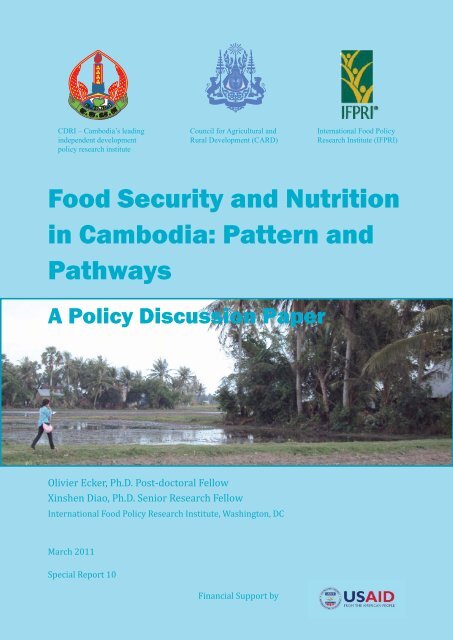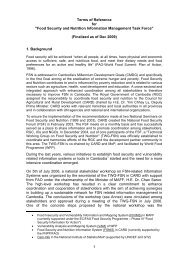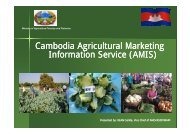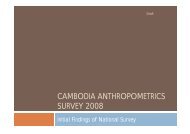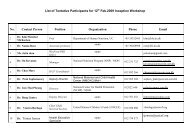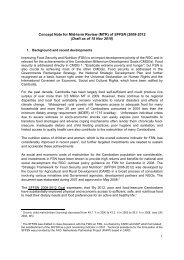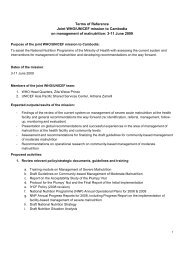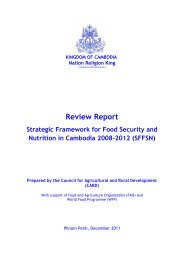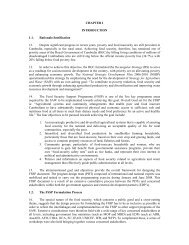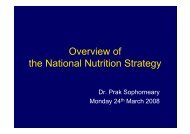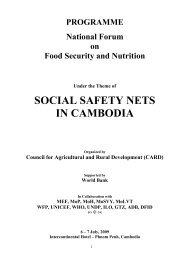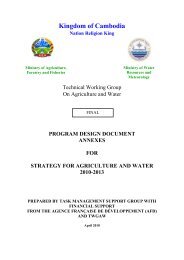Food Security and Nutrition in Cambodia: Pattern and ... - CDRI
Food Security and Nutrition in Cambodia: Pattern and ... - CDRI
Food Security and Nutrition in Cambodia: Pattern and ... - CDRI
You also want an ePaper? Increase the reach of your titles
YUMPU automatically turns print PDFs into web optimized ePapers that Google loves.
<strong>CDRI</strong> – <strong>Cambodia</strong>’s lead<strong>in</strong>g<br />
<strong>in</strong>dependent development<br />
policy research <strong>in</strong>stitute<br />
Council for Agricultural <strong>and</strong><br />
Rural Development (CARD)<br />
International <strong>Food</strong> Policy<br />
Research Institute (IFPRI)<br />
<strong>Food</strong> <strong>Security</strong> <strong>and</strong> <strong>Nutrition</strong><br />
<strong>in</strong> <strong>Cambodia</strong>: <strong>Pattern</strong> <strong>and</strong><br />
Pathways<br />
A Policy Discussion Paper<br />
Olivier Ecker, Ph.D. Post-doctoral Fellow<br />
X<strong>in</strong>shen Diao, Ph.D. Senior Research Fellow<br />
International <strong>Food</strong> Policy Research Institute, Wash<strong>in</strong>gton, DC<br />
March 2011<br />
Special Report 10<br />
F<strong>in</strong>ancial Support by<br />
<strong>Food</strong> <strong>Security</strong> <strong>and</strong> <strong>Nutrition</strong> <strong>in</strong> <strong>Cambodia</strong>: <strong>Pattern</strong>s <strong>and</strong> Pathways<br />
1
<strong>Food</strong> <strong>Security</strong> <strong>and</strong> <strong>Nutrition</strong><br />
<strong>in</strong> <strong>Cambodia</strong>: <strong>Pattern</strong>s <strong>and</strong> Pathways<br />
A Policy Discussion Paper<br />
Olivier Ecker, Ph.D. Post-doctoral Fellow<br />
X<strong>in</strong>shen Diao, Ph.D. Senior Research Fellow<br />
International <strong>Food</strong> Policy Research Institute<br />
Wash<strong>in</strong>gton, DC<br />
Prepared for<br />
<strong>Cambodia</strong> <strong>Food</strong> <strong>Security</strong> <strong>and</strong> Agricultural<br />
Policy Stocktak<strong>in</strong>g Roundtable<br />
4 November 2010 - Phnom Penh Hotel<br />
<strong>CDRI</strong> <strong>in</strong> partnership with<br />
Council for Agricultural <strong>and</strong> Rural Development (CARD)<br />
<strong>and</strong> International <strong>Food</strong> Policy Research Institute (IFPRI)<br />
F<strong>in</strong>ancial Support by USAID<br />
<strong>Food</strong> <strong>Security</strong> <strong>and</strong> <strong>Nutrition</strong> <strong>in</strong> <strong>Cambodia</strong>: <strong>Pattern</strong>s <strong>and</strong> Pathways<br />
i
© 2011 <strong>CDRI</strong> - <strong>Cambodia</strong>’s lead<strong>in</strong>g <strong>in</strong>dependent development policy research <strong>in</strong>stitute<br />
All rights reserved. No part of this publication may be reproduced, stored <strong>in</strong> a retrieval system or<br />
transmitted <strong>in</strong> any form or by any means—electronic, mechanical, photocopy<strong>in</strong>g, record<strong>in</strong>g, or<br />
otherwise—without the written permission of <strong>CDRI</strong>.<br />
ISBN 978–99963-59-00-2<br />
<strong>Food</strong> <strong>Security</strong> <strong>and</strong> <strong>Nutrition</strong> <strong>in</strong> <strong>Cambodia</strong>: <strong>Pattern</strong>s <strong>and</strong> Pathways<br />
A Policy Discussion Paper<br />
March 2011<br />
The responsibility for op<strong>in</strong>ions expressed <strong>in</strong> signed articles, studies <strong>and</strong> other contributions rests<br />
solely with their authors, <strong>and</strong> publication does not necessarily constitute an endorsement by <strong>CDRI</strong><br />
<strong>CDRI</strong><br />
# 56, Street 315, Tuol Kork, Phnom Penh, <strong>Cambodia</strong><br />
PO Box 622, Phnom Penh, <strong>Cambodia</strong><br />
Tel: (+855-23) 881-384/881-701/881-916/883-603/ 012 867-278<br />
Fax: (+855-23) 880-734<br />
E-mail: cdri@wicam.com.kh<br />
Website: http://www.cdri.org.kh<br />
Design <strong>and</strong> Layout: Men Chanthida<br />
Pr<strong>in</strong>ted <strong>and</strong> Bound <strong>in</strong> Phnom Penh, <strong>Cambodia</strong> by T & S Pr<strong>in</strong>t<strong>in</strong>g<br />
ii<br />
A Policy Discussion Paper
Contents<br />
List of Figures <strong>and</strong> Tables ................................................................................................................................................. iv<br />
List of Acronyms .................................................................................................................................................................... v<br />
Executive Summary ............................................................................................................................................................. 1<br />
1. Introduction ....................................................................................................................................................................... 3<br />
2. Conceptual Framework <strong>and</strong> Drivers of <strong>Food</strong> <strong>Security</strong> ..................................................................................... 4<br />
3. <strong>Food</strong> <strong>Security</strong> <strong>and</strong> <strong>Nutrition</strong> <strong>in</strong> <strong>Cambodia</strong> ............................................................................................................. 7<br />
3.1 The status quo <strong>in</strong> the context of regional development .......................................................................... 8<br />
3.2 Changes over time .................................................................................................................................................... 9<br />
3.3 Economic growth as driver of food security <strong>and</strong> nutrition ................................................................. 11<br />
4. Summary <strong>and</strong> Future Research ............................................................................................................................... 16<br />
References ............................................................................................................................................................................. 17<br />
<strong>Food</strong> <strong>Security</strong> <strong>and</strong> <strong>Nutrition</strong> <strong>in</strong> <strong>Cambodia</strong>: <strong>Pattern</strong>s <strong>and</strong> Pathways<br />
iii
iv<br />
A Policy Discussion Paper
List of Acronyms<br />
<strong>CDRI</strong><br />
FAO<br />
GDP<br />
NIS<br />
NSDP<br />
WDI<br />
NIPH<br />
MAFF<br />
MWRM<br />
TWG<br />
FSN<br />
CARD<br />
CNIP<br />
CMDGs<br />
FSNIS<br />
WHO<br />
GDCGM<br />
FSS<br />
MDG<br />
HAZ<br />
WAZ<br />
WHZ<br />
<strong>Cambodia</strong> Development Resource Institute<br />
<strong>Food</strong> <strong>and</strong> Agriculture Organization<br />
Gross Domestic Product<br />
National Institute of Statistics<br />
National Strategic Development Plan<br />
World Development Indicator<br />
National Institute of Public Health<br />
M<strong>in</strong>istry of Forestry <strong>and</strong> Fisheries<br />
M<strong>in</strong>istry of Water Resource <strong>and</strong> Meteorology<br />
Technical Work<strong>in</strong>g Group<br />
<strong>Food</strong> <strong>Security</strong> <strong>and</strong> <strong>Nutrition</strong><br />
Council of Agricultural <strong>and</strong> Rural Development<br />
<strong>Cambodia</strong> <strong>Nutrition</strong> Investment Plan<br />
<strong>Cambodia</strong> Millennium Development Goals<br />
<strong>Food</strong> <strong>Security</strong> <strong>and</strong> <strong>Nutrition</strong> Information System<br />
World Health Organization<br />
Global Database of Child Growth <strong>and</strong> Malnutrition<br />
<strong>Food</strong> <strong>Security</strong> Statistics<br />
Millennium Development Goal<br />
Height-for-age z-scores<br />
weight-for-age z-scores<br />
weight-for-high z-scores<br />
<strong>Food</strong> <strong>Security</strong> <strong>and</strong> <strong>Nutrition</strong> <strong>in</strong> <strong>Cambodia</strong>: <strong>Pattern</strong>s <strong>and</strong> Pathways<br />
v
Executive Summary<br />
This paper provides an overview of the food security <strong>and</strong> nutrition situation <strong>in</strong> <strong>Cambodia</strong>. From a<br />
regional perspective <strong>and</strong> through comparison with its neighbor<strong>in</strong>g countries <strong>and</strong> other countries<br />
<strong>in</strong> Asia, the paper analyzes the patterns of the hunger <strong>and</strong> malnutrition problem <strong>in</strong> <strong>Cambodia</strong><br />
<strong>and</strong> possible pathways the country could follow <strong>in</strong> the future. Between Ch<strong>in</strong>a <strong>and</strong> Vietnam on the<br />
one side <strong>and</strong> India on the other side, the relationship between economic growth <strong>and</strong> the process<br />
of nutrition improvement differs greatly. We expect that these comparisons will help <strong>Cambodia</strong><br />
identify a development pathway to let economic growth better trickle down to the impoverished<br />
population <strong>and</strong> significantly reduce poverty, hunger <strong>and</strong> malnutrition <strong>in</strong> the growth process.<br />
The paper first provides an analytical framework for food security as part of country’s development<br />
strategy. The framework emphasizes the multidimensionality of food security, the cross-sector<br />
nature of the problem, <strong>and</strong> the <strong>in</strong>teractions between the macro <strong>and</strong> the micro levels of economic<br />
<strong>and</strong> social activities <strong>and</strong> policy <strong>in</strong>terventions. This framework offers a useful tool for analyz<strong>in</strong>g how<br />
policies, <strong>in</strong>vestments, programs, <strong>and</strong> external shocks such as the economic impacts of global crises,<br />
climate change, natural disasters, <strong>and</strong> epidemics travel through the economic system to affect food<br />
security <strong>and</strong> nutritional status. Thus, the framework can be applied to address a set of key strategy<br />
research questions such as how to leverage agriculture for better nutrition outcomes <strong>and</strong> which<br />
<strong>in</strong>terventions are most effective <strong>in</strong> this regard.<br />
After provid<strong>in</strong>g an analytic framework, the paper highlights the current food security situation <strong>in</strong><br />
<strong>Cambodia</strong>, based on available data from various sources <strong>in</strong> comb<strong>in</strong>ation with exist<strong>in</strong>g literature.<br />
To better underst<strong>and</strong> <strong>Cambodia</strong>’s development process <strong>in</strong> terms of food <strong>and</strong> nutrition, the analysis<br />
compares <strong>Cambodia</strong>’s situation with that of other Asian countries both <strong>in</strong> the present <strong>and</strong> past.<br />
<strong>Cambodia</strong>’s average GDP per capita rema<strong>in</strong>s low <strong>and</strong> about one-fourth of the population still lives<br />
under the <strong>in</strong>ternational poverty l<strong>in</strong>e of $1.25 a day, with particularly high poverty <strong>in</strong> rural areas.<br />
Hunger <strong>and</strong> malnutrition are still common: every fourth <strong>Cambodia</strong>n suffers from undernourishment,<br />
40 percent of children under five years of age are malnourished, <strong>and</strong> n<strong>in</strong>e out of 100 children die<br />
before they reach their fifth birthday – one of the highest rates <strong>in</strong> South <strong>and</strong> Southeast Asia. These<br />
development <strong>and</strong> nutrition <strong>in</strong>dicators suggest that <strong>Cambodia</strong>’s current situation is similar to that<br />
<strong>in</strong> Lao PDR <strong>and</strong> Bangladesh today, Vietnam <strong>in</strong> the early 2000s, <strong>and</strong> Thail<strong>and</strong> <strong>in</strong> the late 1970s.<br />
Nonetheless, f<strong>in</strong>d<strong>in</strong>gs also show that <strong>Cambodia</strong> has made considerable progress <strong>in</strong> reduc<strong>in</strong>g hunger<br />
<strong>and</strong> malnutrition, despite <strong>in</strong>creased <strong>in</strong>equality <strong>and</strong> high population growth, especially <strong>in</strong> rural<br />
areas. S<strong>in</strong>ce 1993, staple food production has more than doubled, <strong>and</strong> poverty has dropped by<br />
more than one-third. Related to that, the prevalence of child malnutrition has decl<strong>in</strong>ed at a similar<br />
rate as the prevalence of poverty, <strong>and</strong> the percentage of undernourished people has dropped at an<br />
even faster rate. This paper’s analysis shows that there is a positive relationship between nutrition<br />
<strong>in</strong>dicators <strong>and</strong> per capita GDP, <strong>and</strong> that growth has trickled down to reach impoverished people<br />
<strong>and</strong> substantially improve food security <strong>and</strong> nutrition. However, this progress has slowed recently.<br />
Effective policies, <strong>in</strong>vestments, <strong>and</strong> programs are therefore needed to br<strong>in</strong>g the country back on<br />
the successful pathway of its early development, a pathway similar to Ch<strong>in</strong>a <strong>and</strong> Vietnam <strong>in</strong> their<br />
development process.<br />
<strong>Food</strong> <strong>Security</strong> <strong>and</strong> <strong>Nutrition</strong> <strong>in</strong> <strong>Cambodia</strong>: <strong>Pattern</strong>s <strong>and</strong> Pathways<br />
1
Based on the above f<strong>in</strong>d<strong>in</strong>gs this paper suggests more research is needed <strong>in</strong> order to answer the<br />
follow<strong>in</strong>g key questions:<br />
• In addition to economic growth, what are the other major drivers of hunger <strong>and</strong> malnutrition<br />
(<strong>in</strong>clud<strong>in</strong>g micronutrient deficiencies)? How are they l<strong>in</strong>ked with growth <strong>and</strong> <strong>in</strong>terl<strong>in</strong>ked among<br />
themselves, how can they be leveraged for better nutrition outcomes, <strong>and</strong>, <strong>in</strong> particular, what is<br />
the role of agriculture (<strong>in</strong>clud<strong>in</strong>g fisheries) <strong>and</strong> gender?<br />
• Which groups are most vulnerable to hunger <strong>and</strong> malnutrition, where are they located, <strong>and</strong><br />
how can they be better targeted?<br />
• How can government <strong>in</strong>terventions be prioritized through policies, <strong>in</strong>vestments, <strong>and</strong> programs<br />
to more effectively improve <strong>Cambodia</strong>’s food security <strong>and</strong> nutrition situation?<br />
2 A Policy Discussion Paper
1. Introduction<br />
South <strong>and</strong> Southeast Asia has undergone rapid economic growth <strong>in</strong> recent years, fueled by the<br />
miraculous rise of Ch<strong>in</strong>a <strong>and</strong> India. Vietnam <strong>and</strong> <strong>Cambodia</strong>, though their economies are smaller,<br />
have also achieved impressive growth <strong>in</strong> this period. The boom <strong>in</strong> these emerg<strong>in</strong>g economies <strong>and</strong><br />
the strik<strong>in</strong>g success of their recent development process have demonstrated different pathways<br />
to economic transformation <strong>and</strong> will provide lessons for foster<strong>in</strong>g economic growth <strong>in</strong> other<br />
countries.<br />
Thanks to the overall regional transformation, <strong>Cambodia</strong>’s economic development has benefited<br />
from close l<strong>in</strong>ks to its direct neighbors Vietnam <strong>and</strong> Thail<strong>and</strong> <strong>and</strong> other countries <strong>in</strong> the region<br />
such as Ch<strong>in</strong>a. Vietnam, Thail<strong>and</strong>, <strong>and</strong> Ch<strong>in</strong>a are important trade partners for <strong>Cambodia</strong>, <strong>and</strong> the<br />
two neighbor<strong>in</strong>g countries Vietnam <strong>and</strong> Thail<strong>and</strong> have also provided employment opportunities<br />
to <strong>Cambodia</strong>ns through cross-border migration. Moreover, <strong>Cambodia</strong> has kept a close eye on the<br />
progress <strong>and</strong> setbacks of development <strong>in</strong> both Vietnam <strong>and</strong> Thail<strong>and</strong>—the first is a rapidly grow<strong>in</strong>g<br />
emerg<strong>in</strong>g economy while the latter is a middle <strong>in</strong>come country with susta<strong>in</strong>able rapid growth <strong>in</strong><br />
the four decades before the Asian crisis. Aga<strong>in</strong>st the background of regional economic <strong>in</strong>tegration<br />
<strong>and</strong> <strong>in</strong>teractions, <strong>Cambodia</strong>’s development process <strong>and</strong> the associated effects on food security<br />
<strong>and</strong> nutrition improvement will be better understood <strong>in</strong> comparison with the situation <strong>in</strong> other<br />
South <strong>and</strong> Southeast Asian countries. In addition, the experiences of Asian countries at their earlier<br />
stage of development <strong>and</strong> the pathways they took to achieve today’s success can provide relevant<br />
<strong>in</strong>formation to evaluate <strong>Cambodia</strong>’s stage of development <strong>and</strong> give evidence of the opportunities<br />
<strong>and</strong> challenges the country will face <strong>in</strong> the future.<br />
Analysis of the causes <strong>and</strong> drivers of food security <strong>and</strong> nutrition <strong>in</strong> <strong>Cambodia</strong> is limited, <strong>in</strong><br />
contrast to other South <strong>and</strong> Southeast Asian countries such as India, Bangladesh, Ch<strong>in</strong>a, Thail<strong>and</strong>,<br />
<strong>and</strong> Vietnam. Moreover, due to the country’s history, longer-term historical data are either not<br />
available or lack credibility for draw<strong>in</strong>g conclusions on food security <strong>and</strong> nutrition trends <strong>in</strong> the<br />
process of development. Most food security-related studies of <strong>Cambodia</strong> are descriptive <strong>in</strong> nature,<br />
<strong>and</strong> have often provided broad overviews of the food security <strong>and</strong> nutrition situation without<br />
rigorous analysis of causes of food <strong>in</strong>security <strong>and</strong> malnutrition, drivers of change, <strong>and</strong> options for<br />
possible improvements. Examples <strong>in</strong>clude Tucker (1996), who provides a general assessment of<br />
food security <strong>in</strong> <strong>Cambodia</strong>; the report of the st<strong>and</strong>ardized Demographic <strong>and</strong> Health Survey for<br />
2005 (NIPH, NIS, <strong>and</strong> ORC Macro 2006); <strong>and</strong> the <strong>Nutrition</strong> Country Profile of <strong>Cambodia</strong> (FAO<br />
1999). Other, more specific studies ma<strong>in</strong>ly use descriptive statistics or simple micro-econometric<br />
st<strong>and</strong>ard models to evaluate the effect of wealth <strong>in</strong>equality on child malnutrition (Hong & Mishra<br />
2006), the role of food security <strong>in</strong> economic transformation <strong>in</strong> rural areas (Murshid, 1998), <strong>and</strong> the<br />
potentials of regional cooperation for improv<strong>in</strong>g food security <strong>and</strong> foster<strong>in</strong>g development <strong>in</strong> the<br />
Mekong River Bas<strong>in</strong> (Kristensen 2001). The methodology used <strong>in</strong> Fujii (2005) is more advanced,<br />
with small-area estimations used to assess the prevalence of child malnutrition at commune level.<br />
However, the study primarily focused on micro-level assessment <strong>and</strong> did not analyze regional<br />
malnutrition patterns, nor did it provide a reasonable explanation for the scattered picture <strong>and</strong><br />
policy-relevant conclusions.<br />
Thus, the causes <strong>and</strong> drivers of <strong>Cambodia</strong>’s food security <strong>and</strong> nutrition situation, the available policy<br />
options, <strong>and</strong> the <strong>in</strong>terventions most likely to be effective are all little understood. Moreover, available<br />
studies fail to look at <strong>Cambodia</strong>’s food security <strong>and</strong> nutrition situation from a regional development<br />
perspective or to identify common or different patterns between <strong>Cambodia</strong> <strong>and</strong> other countries<br />
<strong>in</strong> the region, so that lessons learned from these countries can be utilized for design<strong>in</strong>g effective<br />
development strategies <strong>and</strong> practical food security <strong>and</strong> nutrition <strong>in</strong>terventions <strong>in</strong> <strong>Cambodia</strong>. More<br />
<strong>Food</strong> <strong>Security</strong> <strong>and</strong> <strong>Nutrition</strong> <strong>in</strong> <strong>Cambodia</strong>: <strong>Pattern</strong>s <strong>and</strong> Pathways<br />
3
esearch <strong>in</strong> this direction is clearly needed to support <strong>and</strong> realize the objectives of <strong>Cambodia</strong>’s <strong>Food</strong><br />
<strong>Security</strong> <strong>and</strong> <strong>Nutrition</strong> Strategy (CARD 2008, MAFF & MWRM 2008). Aga<strong>in</strong>st this background, the<br />
purpose of this paper is twofold: As a stocktak<strong>in</strong>g exercise, it tries to underst<strong>and</strong> <strong>Cambodia</strong>’s food<br />
security <strong>and</strong> nutrition situation with<strong>in</strong> the context of regional economic transformation, <strong>and</strong>, with<br />
that underst<strong>and</strong><strong>in</strong>g, it serves as a basis for discussion of future policy research topics.<br />
The rest of the paper is organized as follows. The next section presents a conceptual framework<br />
for food <strong>and</strong> nutrition security analysis from a development strategy perspective. The framework<br />
emphasizes <strong>in</strong>teractions <strong>and</strong> l<strong>in</strong>kages of factors that affect food security <strong>and</strong> nutrition status at both<br />
macro <strong>and</strong> micro levels. The third section analyzes the trends <strong>and</strong> current situation of <strong>Cambodia</strong>’s<br />
food security <strong>and</strong> nutrition <strong>in</strong> the regional context. The role of economic growth as a driver of<br />
food security <strong>and</strong> nutrition is highlighted us<strong>in</strong>g available data <strong>and</strong> various key development <strong>and</strong><br />
nutrition <strong>in</strong>dicators. The last section concludes by propos<strong>in</strong>g some future research topics relevant<br />
to policy decisions.<br />
2. Conceptual Framework <strong>and</strong> Drivers of <strong>Food</strong> <strong>Security</strong><br />
The concept of food security – as understood today – offers a useful <strong>and</strong> comprehensive framework<br />
for analyz<strong>in</strong>g people’s food <strong>and</strong> nutrition situation <strong>and</strong> underst<strong>and</strong><strong>in</strong>g the key drivers. Today’s<br />
common def<strong>in</strong>ition was co<strong>in</strong>ed at the World <strong>Food</strong> Summit of 1996. <strong>Food</strong> security is achieved “when<br />
all people, at all times, have physical, social <strong>and</strong> economic access to sufficient, safe <strong>and</strong> nutritious<br />
food to meet their dietary needs <strong>and</strong> food preferences for an active <strong>and</strong> healthy life” (FAO 1996).<br />
To achieve such a situation requires concerted action at <strong>in</strong>dividual, household, national, regional,<br />
<strong>and</strong> global levels (FAO 1996). At the World Summit of <strong>Food</strong> <strong>Security</strong> of 2009, the <strong>in</strong>ternational<br />
community reconfirmed this concept, specified the “four pillars of food security that are availability,<br />
access, utilization, <strong>and</strong> stability”, <strong>and</strong> emphasized that “the nutritional dimension is <strong>in</strong>tegral to the<br />
concept” (FAO 2009). This multi-dimensional <strong>and</strong> <strong>in</strong>tegrated def<strong>in</strong>ition of food security underl<strong>in</strong>es<br />
this paper <strong>and</strong> is consistent with the guid<strong>in</strong>g pr<strong>in</strong>ciple of the Royal Government of <strong>Cambodia</strong>.<br />
In the late 2004, the <strong>Cambodia</strong>n government created a cross-m<strong>in</strong>isterial Technical Work<strong>in</strong>g<br />
Group on <strong>Food</strong> <strong>Security</strong> <strong>and</strong> <strong>Nutrition</strong> (TWG-FSN) to promote ma<strong>in</strong>stream<strong>in</strong>g food security <strong>and</strong><br />
nutrition <strong>in</strong>to sector policies <strong>and</strong> strategies <strong>and</strong> to support its <strong>in</strong>tegration <strong>in</strong> the decentralized<br />
plann<strong>in</strong>g process. The coord<strong>in</strong>at<strong>in</strong>g body of the TWG-FSN is the Council for Agricultural <strong>and</strong><br />
Rural Development (CARD). The <strong>Food</strong> <strong>Security</strong> <strong>and</strong> <strong>Nutrition</strong> Information System (FSNIS)—the<br />
<strong>in</strong>formation <strong>and</strong> communication platform of the TWG-FSN—notes: “<strong>Food</strong> security is a cross-cutt<strong>in</strong>g<br />
issue … the elim<strong>in</strong>ation of food <strong>and</strong> nutritional <strong>in</strong>security <strong>in</strong> <strong>Cambodia</strong>, <strong>and</strong> the atta<strong>in</strong>ment of<br />
<strong>Cambodia</strong>n first Millennium Development Goal to eradicate extreme poverty <strong>and</strong> hunger, dem<strong>and</strong>s<br />
a specific, comprehensive <strong>and</strong> <strong>in</strong>tegrated approach focus<strong>in</strong>g on … [food] availability, access <strong>and</strong> use<br />
<strong>and</strong> utilization. Furthermore, food security <strong>and</strong> vulnerability need to be tackled at the national,<br />
household <strong>and</strong> <strong>in</strong>dividual level. <strong>Food</strong> security <strong>and</strong> nutrition are at the forefront of discussions<br />
among <strong>Cambodia</strong>’s policy-makers, who are <strong>in</strong>corporat<strong>in</strong>g food security <strong>and</strong> nutrition-related goals<br />
<strong>and</strong> objectives <strong>in</strong> national strategies <strong>and</strong> frameworks such as the <strong>Cambodia</strong> <strong>Nutrition</strong> Investment<br />
Plan (CNIP) 2003-2007, the <strong>Cambodia</strong> Millennium Development Goals (CMDGs), the Rectangular<br />
Strategy <strong>and</strong> the National Strategic Development Plan (NSDP) 2006-2010” (FSNIS 2010).<br />
A conceptual framework to <strong>in</strong>tegrate food security <strong>in</strong>to a country’s development strategy analysis<br />
is presented <strong>in</strong> Figure 1. Explor<strong>in</strong>g effective strategies <strong>and</strong> policy <strong>in</strong>struments to achieve food<br />
security as def<strong>in</strong>ed by the World <strong>Food</strong> Summit requires a comprehensive <strong>and</strong> <strong>in</strong>tegrated approach<br />
that considers the cross-sector <strong>and</strong> multi-level nature of the food <strong>in</strong>security problem <strong>and</strong><br />
identifies efficient pathways <strong>and</strong> suitable bodies with<strong>in</strong> a country’s government for tak<strong>in</strong>g action.<br />
4 A Policy Discussion Paper
For analytical purposes, the framework differentiates food security at the national <strong>and</strong> regional<br />
level—the macro level—<strong>and</strong> at the household <strong>and</strong> <strong>in</strong>dividual level—the micro level. These are<br />
<strong>in</strong>terconnected through various l<strong>in</strong>ks.<br />
Figure 1: Conceptual framework of food security for country development strategy analysis<br />
Strategies & Intervenons<br />
THE MACRO LEVEL: Naonal/Regional Economy & Key Sectors<br />
External Shocks<br />
Macro, Sector Policies &<br />
Public Investments<br />
Infrastructure<br />
& Trade<br />
Agriculture<br />
Health &<br />
Educaon<br />
Global Economic Crises<br />
& Climate Change<br />
The MICRO LEVEL: Household & Individuals<br />
Social Protecon<br />
Availability<br />
& Access<br />
Conflicts &<br />
Natural Disasters<br />
<strong>Food</strong><br />
Income<br />
Prices<br />
Producon<br />
for own<br />
consumpon<br />
HH Property &<br />
Basic Services<br />
Shelter<br />
Water &<br />
Sanitaon<br />
Health Care<br />
Educaon<br />
Care & Intra-household<br />
Resource Allocaon<br />
Nutrion & Health<br />
Programs<br />
<strong>Food</strong> & Nutrient<br />
Intake<br />
Health Status<br />
Epidemics<br />
Nutrional<br />
Status<br />
Capacity &<br />
Producvity<br />
ECONOMIC & SOCIAL<br />
DEVELOPMENT<br />
Source: Own presentation.<br />
Macro-level food security should not be misunderstood as food self-sufficiency; rather, it refers to<br />
the balance of food supply <strong>and</strong> dem<strong>and</strong> for a particular country or region <strong>in</strong> which requirements <strong>in</strong><br />
both food quantity <strong>and</strong> quality can be met through domestic/local production or by available <strong>and</strong><br />
affordable imports. Thus, macro-level food security is determ<strong>in</strong>ed by the structure <strong>and</strong> performance<br />
of the domestic economy. Key sectors for achiev<strong>in</strong>g a state of food security at the national <strong>and</strong><br />
regional level are agriculture that provides available food domestically produced, <strong>and</strong> a food<br />
supply cha<strong>in</strong> that moves food through the market from producers to consumers, which <strong>in</strong>volves<br />
a trad<strong>in</strong>g system, <strong>in</strong>frastructure, <strong>and</strong> various market <strong>in</strong>stitutions. In early stages of development,<br />
the agricultural sector plays the central role for food security <strong>in</strong> most develop<strong>in</strong>g countries for<br />
various reasons. Most obviously, agriculture produces food <strong>and</strong> provides jobs to the vast majority<br />
of people, especially the poor. In addition, agricultural growth often drives overall economic<br />
growth <strong>and</strong> promotes more shared growth, while <strong>in</strong>creased <strong>in</strong>equality is often associated with<br />
non-agricultural growth (Breis<strong>in</strong>ger & Diao 2008, Diao et al. 2007). Given the <strong>in</strong>teraction between<br />
nutrition, health, <strong>and</strong> education at the micro level (which will be discussed below) <strong>and</strong> the fact that<br />
nutrition-related <strong>in</strong>tervention programs (for example, school feed<strong>in</strong>g <strong>and</strong> food supplementation)<br />
are often under the responsibility of the m<strong>in</strong>istry of education or the m<strong>in</strong>istry of health or both,<br />
the health <strong>and</strong> education sectors constitute the third pillar of macro-level food security. The three<br />
pillars of macro-level food security are horizontally closely l<strong>in</strong>ked, creat<strong>in</strong>g competition <strong>and</strong> form<strong>in</strong>g<br />
synergies. An example of compet<strong>in</strong>g l<strong>in</strong>ks between agriculture <strong>and</strong> health is the alternative uses of<br />
<strong>Food</strong> <strong>Security</strong> <strong>and</strong> <strong>Nutrition</strong> <strong>in</strong> <strong>Cambodia</strong>: <strong>Pattern</strong>s <strong>and</strong> Pathways<br />
5
water for irrigation, livestock production, <strong>and</strong> food process<strong>in</strong>g or for direct human consumption. An<br />
example of synergetic l<strong>in</strong>ks between <strong>in</strong>frastructure <strong>and</strong> health <strong>and</strong> education is the road network<br />
connect<strong>in</strong>g people to markets <strong>and</strong> enabl<strong>in</strong>g access to basic services such as primary education <strong>and</strong><br />
health care.<br />
Beyond the provision of goods <strong>and</strong> services, the macro level l<strong>in</strong>ks to the micro level through the<br />
dem<strong>and</strong> for capital, labor, <strong>and</strong> l<strong>and</strong> held by the households <strong>and</strong> their compensation for the use of<br />
production factors. These vertical l<strong>in</strong>ks mutually contribute to achiev<strong>in</strong>g food security at the macro<br />
<strong>and</strong> the micro level. However, macro-level food security is a necessary but <strong>in</strong>sufficient condition for<br />
micro-level food security.<br />
The micro level comprises the household <strong>and</strong> all <strong>in</strong>dividual members of a household. Micro-level<br />
food security is determ<strong>in</strong>ed by the availability of sufficient <strong>and</strong> nutritious food, nutrition-relevant<br />
properties <strong>and</strong> basic services, as well as the access of the <strong>in</strong>dividual to these vital needs. In most<br />
cases, access is constra<strong>in</strong>ed by economic means, i.e. (absolute) poverty. Limited physical access can<br />
be often overcome by spend<strong>in</strong>g capacity, for example through pay<strong>in</strong>g for transportation to markets.<br />
Thus, the most important—but not sole—determ<strong>in</strong>ant of food security is household <strong>in</strong>come <strong>and</strong>,<br />
<strong>in</strong> subsistence-oriented households, food production for own consumption. Given that most food<br />
<strong>in</strong>secure people live <strong>in</strong> agrarian, semi-<strong>in</strong>tegrated market economies, there is an absolute <strong>and</strong><br />
seasonal tradeoff between <strong>in</strong>come earn<strong>in</strong>g <strong>and</strong> food self-sufficiency that is essentially determ<strong>in</strong>ed<br />
by the price for goods <strong>and</strong> production factors (wage) <strong>and</strong> transaction costs. But this tradeoff is<br />
also <strong>in</strong>fluenced by the availability of opportunities <strong>and</strong> alternatives, decision makers’ assessment<br />
of risks, <strong>in</strong>stances of emergency, <strong>and</strong> other factors. Farmers face decisions about the cultivation of<br />
cash or staple crops, time allocation for farm <strong>and</strong> off-farm activities, sell<strong>in</strong>g or stor<strong>in</strong>g of harvest,<br />
<strong>and</strong> other issues. Also, particularly for the poor <strong>in</strong> develop<strong>in</strong>g countries, who are usually net food<br />
buyers <strong>and</strong> who spend significantly more than half their <strong>in</strong>come on food, food prices are a key factor<br />
for food security. High prices reduce a household’s real <strong>in</strong>come, <strong>and</strong> relative food price changes<br />
affect the food consumption patterns that might give rise to <strong>in</strong>creas<strong>in</strong>g micronutrient deficiencies<br />
(Ecker & Qaim 2010).<br />
Beyond the availability of sufficient <strong>and</strong> nutritious food <strong>in</strong> the household, <strong>in</strong>dividual dietary <strong>in</strong>take<br />
is determ<strong>in</strong>ed by a set of non-<strong>in</strong>come factors. Individual access to proper food is subject to <strong>in</strong>trahousehold<br />
resource allocation <strong>and</strong> care for the <strong>in</strong>dividual, both of which <strong>in</strong> turn depend on the<br />
personality of the decision maker <strong>and</strong> gender roles, education <strong>and</strong> knowledge, available time, <strong>and</strong><br />
cultural <strong>and</strong> social customs. Especially for the nutrition <strong>and</strong> health of young children, mothers’ (or<br />
caretakers’) health, ability, <strong>and</strong> capability are central. S<strong>in</strong>ce the children’s mother is often also the<br />
person responsible for meal preparation, she is the most important other-person for the nutrition<br />
of all household members as well. Besides adequate dietary <strong>in</strong>take, <strong>in</strong>dividual health status<br />
affects nutritional status substantially. For example, highly prevalent <strong>in</strong>fectious diseases such as<br />
malaria or diarrhea caused by <strong>in</strong>test<strong>in</strong>al parasites significantly reduce the absorption of nutrients<br />
(especially of micronutrients), so that higher nutrient <strong>in</strong>take is necessary to cover the losses, if such<br />
compensation is possible at all. On the other h<strong>and</strong>, poor nutrition weakens the human immune<br />
system <strong>and</strong> thus <strong>in</strong>creases risk of <strong>in</strong>fection. Liv<strong>in</strong>g conditions also affect the health of all household<br />
members that depend on household property <strong>and</strong> access to basic (public) services, often limited<br />
due to poor <strong>in</strong>frastructural development. Proper shelter, clean dr<strong>in</strong>k<strong>in</strong>g water, hygienic sanitation,<br />
<strong>and</strong> access to basic health care such as disease treatment, vacc<strong>in</strong>ation, <strong>and</strong> mother <strong>and</strong> child care<br />
programs all affect people’s nutrition <strong>in</strong>directly, through the l<strong>in</strong>k with health.<br />
Healthy nutrition is fundamental for realiz<strong>in</strong>g the physical <strong>and</strong> mental capacity <strong>and</strong> productivity<br />
of people <strong>and</strong> their social potential. Thus, it is the basis for the well-be<strong>in</strong>g of <strong>in</strong>dividuals <strong>and</strong><br />
households as well as for economic development <strong>and</strong> the formation of societies <strong>in</strong> communities<br />
6 A Policy Discussion Paper
<strong>and</strong> countries. Even temporary food shortages <strong>and</strong> nutrient deficiencies can cause irreversible<br />
health impairments <strong>in</strong> <strong>in</strong>dividuals <strong>and</strong> serious long-term consequences for economic growth <strong>and</strong><br />
development potential of a society. External shocks, such as global economic crises, climate change,<br />
conflicts, natural disasters, <strong>and</strong> epidemics, can threaten macro- <strong>and</strong> micro-level food security.<br />
The goal of development strategies <strong>in</strong> the context of food security is to <strong>in</strong>crease the efficiency<br />
of exist<strong>in</strong>g measures <strong>and</strong> to propose effective alternatives strengthen<strong>in</strong>g the l<strong>in</strong>kages described<br />
above <strong>in</strong> order to achieve better nutrition outcomes. Governments <strong>and</strong> their operational bodies<br />
have different options for <strong>in</strong>terven<strong>in</strong>g <strong>and</strong> govern<strong>in</strong>g at different levels that <strong>in</strong>clude structural <strong>and</strong><br />
sector policies, public <strong>in</strong>vestments, social protection measures, <strong>and</strong> direct nutrition <strong>and</strong> health<br />
programs. In this context, research can assist by provid<strong>in</strong>g important knowledge <strong>and</strong> advice based<br />
on rigorous analysis.<br />
3. <strong>Food</strong> <strong>Security</strong> <strong>and</strong> <strong>Nutrition</strong> <strong>in</strong> <strong>Cambodia</strong><br />
Historical evidence shows that economic growth generally leads to improvement <strong>in</strong> human<br />
nutrition, while the most obvious <strong>and</strong> direct pathway from economic growth to improved nutrition<br />
is via household <strong>in</strong>come. If growth leads to higher <strong>in</strong>come at household level, people are able to<br />
consume more food with higher nutritional value. This results <strong>in</strong> the improvement of nutritional<br />
status for a majority of the population. However, this trickle-down effect can be <strong>in</strong>terrupted at<br />
different levels <strong>and</strong> at different po<strong>in</strong>ts. For example, <strong>in</strong>come distribution <strong>and</strong> the proportion of<br />
growth ga<strong>in</strong>s go<strong>in</strong>g to the poor matter substantially at the national level. Also, <strong>in</strong>tra-household<br />
distribution is important <strong>in</strong> determ<strong>in</strong><strong>in</strong>g whether <strong>in</strong>come growth benefits an <strong>in</strong>dividual family<br />
member. In addition, there are other pathways that cross <strong>and</strong> <strong>in</strong>teract with the <strong>in</strong>come pathway,<br />
as the previous section outl<strong>in</strong>ed. Another possibility by which growth results <strong>in</strong> better nutrition<br />
outcomes is public policy <strong>in</strong>terventions. Economic growth generates more government revenue<br />
<strong>and</strong> enables the government to design nutrition-related programs such as school feed<strong>in</strong>g, or to<br />
exp<strong>and</strong> public health <strong>and</strong> education services.<br />
The vast differences <strong>in</strong> nutrition situation <strong>and</strong> nutrition improvement over time among develop<strong>in</strong>g<br />
countries show that some countries’ growth trickles down more than others’, <strong>and</strong> that some<br />
governments have been more successful <strong>in</strong> leverag<strong>in</strong>g economic growth for better nutrition<br />
outcomes, while others succeeded less <strong>and</strong> few even failed. Successful countries are those that<br />
have developed an effective policy package foster<strong>in</strong>g high <strong>and</strong> stable <strong>in</strong>come growth benefit<strong>in</strong>g<br />
the poor, comb<strong>in</strong>ed with <strong>in</strong>terventions target<strong>in</strong>g the most vulnerable population groups. Although<br />
such a mix of policy options must be designed to country-specific conditions, successful countries<br />
that share similar <strong>in</strong>itial conditions tend to have common patterns <strong>and</strong> follow similar pathways.<br />
Thus, identify<strong>in</strong>g these patterns <strong>and</strong> underst<strong>and</strong><strong>in</strong>g those pathways can help other, less progressed<br />
countries <strong>in</strong> creat<strong>in</strong>g their own success story. Country comparison analysis is often a powerful tool to<br />
deduce general lessons <strong>and</strong> pathways that latecomers might follow. When compar<strong>in</strong>g food security<br />
progress across countries, it is important to consider <strong>in</strong>itial conditions. Achiev<strong>in</strong>g high reduction<br />
rates <strong>in</strong> hunger <strong>and</strong> malnutrition tends to be easier <strong>in</strong> the countries with high prevalence rates,<br />
compared to countries that have already lowered prevalence rates <strong>in</strong> their early development.<br />
We first focus on the current situation of development <strong>and</strong> food security <strong>in</strong> <strong>Cambodia</strong> <strong>and</strong> identify<br />
the time when other South <strong>and</strong> Southeast countries had achieved similar states. Ch<strong>in</strong>a, Lao PDP,<br />
Thail<strong>and</strong>, Vietnam, India, <strong>and</strong> Bangladesh are chosen <strong>in</strong> the comparison. The development <strong>in</strong>dicators<br />
at the macro level are total GDP growth, agricultural growth, share of agriculture <strong>in</strong> GDP, <strong>and</strong> female<br />
adult literacy. The micro-level <strong>in</strong>dicators are those that are used to measure poverty, hunger, child<br />
malnutrition, <strong>and</strong> child mortality. The data are compiled from various public sources, <strong>in</strong>clud<strong>in</strong>g<br />
the World Development Indicators (World Bank 2010), the <strong>Food</strong> <strong>Security</strong> Statistics database of<br />
<strong>Food</strong> <strong>Security</strong> <strong>and</strong> <strong>Nutrition</strong> <strong>in</strong> <strong>Cambodia</strong>: <strong>Pattern</strong>s <strong>and</strong> Pathways<br />
7
FAO (FSS 2010), <strong>and</strong> the Global Database of Child Growth <strong>and</strong> Malnutrition of the World Health<br />
Organization (WHO) (GDCGM 2010).<br />
3.1 The status quo <strong>in</strong> the context of regional development<br />
<strong>Cambodia</strong> is a low-<strong>in</strong>come country with an average per capita <strong>in</strong>come of US$500 <strong>in</strong> 2008. Among<br />
the countries compared <strong>in</strong> this study, only Lao PDR <strong>and</strong> Bangladesh have lower per capita <strong>in</strong>come<br />
levels. While 2008 per capita <strong>in</strong>come <strong>in</strong> Vietnam <strong>and</strong> India is modestly higher, per capita <strong>in</strong>come<br />
<strong>in</strong> Ch<strong>in</strong>a <strong>and</strong> Thail<strong>and</strong> is respectively four <strong>and</strong> five times that of <strong>Cambodia</strong> (Table 1, first panel <strong>and</strong><br />
first column). Table 1 also reports the year <strong>in</strong> which each of the compared countries last had <strong>in</strong>come<br />
levels on par with <strong>Cambodia</strong>’s today. India <strong>and</strong> Vietnam reached <strong>Cambodia</strong>’s current <strong>in</strong>come level<br />
only a few years earlier, as per capita <strong>in</strong>come is comparable between India <strong>in</strong> 2003, Vietnam <strong>in</strong><br />
2004, <strong>and</strong> <strong>Cambodia</strong> <strong>in</strong> 2008. On the other h<strong>and</strong>, Ch<strong>in</strong>a <strong>and</strong> Thail<strong>and</strong> reached per capital <strong>in</strong>come<br />
level of US$500 <strong>in</strong> 1993 <strong>and</strong> 1970, respectively (Table 1, first panel <strong>and</strong> second column).<br />
The agricultural sector still plays a major role <strong>in</strong> <strong>Cambodia</strong>’s economy, account<strong>in</strong>g for 35% of GDP.<br />
Agriculture has a similar share of GDP <strong>in</strong> Lao PDR as does <strong>Cambodia</strong>, while agricultural share of<br />
GDP is low <strong>in</strong> all other countries, <strong>in</strong>clud<strong>in</strong>g Bangladesh, where per capita <strong>in</strong>come is lower than that<br />
<strong>in</strong> <strong>Cambodia</strong> at the present (Table 1, first panel <strong>and</strong> third column).<br />
Literacy rate among female adults is an important social development <strong>in</strong>dicator, <strong>and</strong> it is also<br />
important for child feed<strong>in</strong>g practices <strong>and</strong> hence for improv<strong>in</strong>g child nutrition <strong>and</strong> health (Guldan<br />
et al. 1993). Thus, we consider this <strong>in</strong>dicator <strong>in</strong> the comparison. As shown <strong>in</strong> the second panel of<br />
Table 1, <strong>in</strong> <strong>Cambodia</strong>, about 70% of all females aged 15 years <strong>and</strong> older are literate. While this rate<br />
is comparable with Lao PDR, it is considerably higher than <strong>in</strong> Bangladesh <strong>and</strong> India. As expected, a<br />
much higher rate of female literacy is observed <strong>in</strong> Ch<strong>in</strong>a <strong>and</strong> Vietnam as well as <strong>in</strong> Thail<strong>and</strong>.<br />
Poverty <strong>and</strong> hunger (or undernourishment) still affect more than one-fourth of <strong>Cambodia</strong>ns<br />
today. Nonetheless, poverty is about half as prevalent as <strong>in</strong> Bangladesh <strong>and</strong> about two-thirds as<br />
prevalent as <strong>in</strong> India <strong>and</strong> Lao PDR. However, <strong>in</strong> contrast to the poverty patterns, the prevalence of<br />
undernourishment (hunger) <strong>in</strong> <strong>Cambodia</strong>, that is, the percentage of people consum<strong>in</strong>g less than<br />
the m<strong>in</strong>imum requirement of calories, is almost the same as that <strong>in</strong> Bangladesh <strong>and</strong> only slightly<br />
higher than that <strong>in</strong> India. On the other h<strong>and</strong>, the prevalence of undernourishment is lower <strong>in</strong> Lao<br />
PDR than <strong>in</strong> <strong>Cambodia</strong>, although Lao PDR has a higher level of poverty <strong>and</strong> lower level of per capita<br />
<strong>in</strong>come than <strong>Cambodia</strong> does.<br />
Three anthropometric <strong>in</strong>dicators are used to measure the status of child malnutrition 1 . As reported<br />
<strong>in</strong> the third panel of Table 1 <strong>and</strong> consistent with the <strong>in</strong>come level, child malnutrition <strong>in</strong> <strong>Cambodia</strong> is<br />
higher than that <strong>in</strong> Vietnam, Ch<strong>in</strong>a <strong>and</strong> Thail<strong>and</strong>, but is less widespread than <strong>in</strong> Lao PDR, Bangladesh<br />
<strong>and</strong> India. However, the mortality rate among <strong>Cambodia</strong>n children younger than 5 years is the<br />
highest among the compared countries.<br />
Taken together, the <strong>in</strong>dicators suggests that <strong>Cambodia</strong>’s stage of development <strong>and</strong> food security<br />
situation is similar to that of Lao PDR <strong>and</strong> Bangladesh today, Vietnam at the beg<strong>in</strong>n<strong>in</strong>g of the 2000,<br />
<strong>and</strong> Thail<strong>and</strong> <strong>in</strong> the late 1970s. The situation <strong>in</strong> India at the present <strong>and</strong> <strong>in</strong> the past somehow<br />
1 These <strong>in</strong>dicators are height-for-age, weight-for-height, <strong>and</strong> weight-for-age. Children are considered as<br />
moderately <strong>and</strong> severely underweight, stunted, or wasted, if their weight-for-age z-scores (WAZ), heightfor-age<br />
z-scores (HAZ), or weight-for-height z-scores (WHZ) are below certa<strong>in</strong> critical values. These<br />
three <strong>in</strong>dicators have different implications for child nutrition <strong>and</strong> cannot be used <strong>in</strong>terchangeably<br />
(WHO 1995).<br />
8 A Policy Discussion Paper
differs from <strong>Cambodia</strong>’s, particularly <strong>in</strong> terms of India’s relatively advanced economic stage today<br />
<strong>and</strong> the worse nutrition situation among children.<br />
3.2 Changes over time<br />
Us<strong>in</strong>g the same data sources discussed <strong>in</strong> the previous subsection, we further exam<strong>in</strong>e the trends <strong>in</strong><br />
<strong>Cambodia</strong>’s economic development <strong>and</strong> its progress toward food security <strong>in</strong> 1993–2008. <strong>Cambodia</strong><br />
has experienced rapid economic growth s<strong>in</strong>ce 1993, especially after the turn of the millennium<br />
(Naron 2009). Between 1993 <strong>and</strong> 1998, the GDP grew by 6.3% annually <strong>and</strong> by 9.5% between<br />
1999 <strong>and</strong> 2008. For the agricultural sector, despite negative growth <strong>in</strong> 2000 <strong>and</strong> 2002, the sector’s<br />
value added grew at 4.6% between 1993 <strong>and</strong> 2008 with little differences before <strong>and</strong> after the<br />
Asian crisis. Even more importantly, as suggested by FAO’s food production <strong>in</strong>dex, food production<br />
<strong>in</strong>creased by more than 2.5 times s<strong>in</strong>ce 1993 (FSS 2010).<br />
However, <strong>Cambodia</strong>’s population is also one of the fastest-grow<strong>in</strong>g <strong>in</strong> South <strong>and</strong> Southeast Asia.<br />
From 1993 to 2008, population grew at 2.3% annually. The number of people who are economically<br />
active <strong>in</strong> agriculture grew more rapidly, with an annual rate of 3.0%. Given high population growth<br />
rate <strong>in</strong> the rural area, the agricultural value added per agricultural worker grew by 1.9% only,<br />
<strong>in</strong> contrast to the impressive per capita GDP growth rate of 6.3% annually. Income <strong>in</strong>equality,<br />
measured by the GINI coefficient, has been worsen<strong>in</strong>g <strong>in</strong> <strong>Cambodia</strong> dur<strong>in</strong>g its rapid growth period.<br />
In 1994, the GINI coefficient was 38.3, <strong>and</strong> <strong>in</strong> 2007, it was 44.2. Thus, <strong>Cambodia</strong> becomes a country<br />
with the most rapid <strong>in</strong>crease <strong>in</strong> GINI coefficient <strong>in</strong> South <strong>and</strong> Southeast Asia today.<br />
In spite of the rapid <strong>in</strong>crease of <strong>in</strong>come <strong>in</strong>equality, poverty decl<strong>in</strong>ed tremendously, from 47% <strong>in</strong><br />
1994 to 30% <strong>in</strong> 2007. While progress has been made <strong>in</strong> both rural <strong>and</strong> urban areas, the poverty<br />
rate is still as high as 35% <strong>in</strong> the rural area <strong>in</strong> 2007, much higher than the urban poverty rate. Fast<br />
economic growth <strong>in</strong> urban areas <strong>and</strong> relatively slow progress <strong>in</strong> rural poverty reduction might<br />
have contributed to <strong>in</strong>creas<strong>in</strong>g countrywide <strong>in</strong>come <strong>in</strong>equality.<br />
In reduc<strong>in</strong>g undernourishment <strong>and</strong> child malnutrition, <strong>Cambodia</strong> achieved notable success over<br />
the past two decades. Despite setbacks dur<strong>in</strong>g the Asian crisis, the prevalence of undernourishment<br />
was brought down from 38% <strong>in</strong> 1992 to 25% <strong>in</strong> 2006. While 59% of all children under five years of<br />
age were stunted <strong>and</strong> 43% underweight <strong>in</strong> 1996, the <strong>in</strong>dicators decl<strong>in</strong>ed to 40% for stunt<strong>in</strong>g <strong>and</strong><br />
29% for underweight <strong>in</strong> 2008. Although progress <strong>in</strong> reduc<strong>in</strong>g child mortality has gathered pace,<br />
particularly s<strong>in</strong>ce 2000, <strong>Cambodia</strong> seems unlikely to meet the fourth Millennium Development<br />
Goal (MDG) of reduc<strong>in</strong>g the under-five mortality rate by two thirds between 1990 <strong>and</strong> 2015. In<br />
1980, 150 out of 1,000 children younger than five years of age died from malnutrition, poor health,<br />
or other preventable causes <strong>in</strong> <strong>Cambodia</strong>. The mortality rate decl<strong>in</strong>ed to 117 <strong>in</strong> 1990 <strong>and</strong> 90 <strong>in</strong><br />
2008. While this progress is impressive, the gap between the achievement <strong>and</strong> the target of the<br />
fourth MDG is significant.<br />
<strong>Food</strong> <strong>Security</strong> <strong>and</strong> <strong>Nutrition</strong> <strong>in</strong> <strong>Cambodia</strong>: <strong>Pattern</strong>s <strong>and</strong> Pathways<br />
9
Table 1:<br />
The state of food security <strong>in</strong> <strong>Cambodia</strong> <strong>and</strong> comparable states <strong>in</strong> the process of other<br />
countries’ development<br />
GDP per capita<br />
(constant 2000 US$)<br />
Agriculture value added<br />
(% of GDP)<br />
Agriculture value added<br />
per worker<br />
(constant 2000 US$)<br />
2008 Comparable<br />
state <strong>in</strong><br />
2008 Comparable<br />
state <strong>in</strong><br />
2008 Comparable<br />
state <strong>in</strong><br />
<strong>Cambodia</strong> 511 35 388<br />
Bangladesh 462 - 19 1980 418 2006<br />
Lao PDR 475 - 35 2008 516 1992<br />
Vietnam 647 2004 22 1992 352 -<br />
India 718 2003 17 1978 478 1994<br />
Ch<strong>in</strong>a 1,965 1993 11 1970 504 2002<br />
Thail<strong>and</strong> 2,640 1970 12 1961 705 1980<br />
East Asia & Pacific 1,760 1991 12 1961 534 1999<br />
World 6,007 n.a. 3 n.a. 878 n.a.<br />
Female adult literacy<br />
rate (% of females aged<br />
15 <strong>and</strong> above)<br />
2005-08 Comparable<br />
state <strong>in</strong><br />
Poverty headcount rao<br />
at $1.25 a day (PPP)<br />
(% of populaon)<br />
Prevalence of<br />
undernourishment<br />
(% of populaon)<br />
2005-07 Comparable<br />
state <strong>in</strong><br />
2005-07 Comparable<br />
state <strong>in</strong><br />
<strong>Cambodia</strong> 69 26 25<br />
Bangladesh 50 - 50 - 26 -<br />
Lao PDR 63 - 44 - 19 1997<br />
Vietnam 90
Figure 2: Trends of poverty reduction <strong>in</strong> <strong>Cambodia</strong> <strong>and</strong> selected<br />
other South <strong>and</strong> Southeast countries<br />
0.8<br />
0.7<br />
0.6<br />
Lao PDR<br />
0.5<br />
0.4<br />
Bangladesh<br />
India<br />
0.3<br />
0.2<br />
0.1<br />
Ch<strong>in</strong>a<br />
<strong>Cambodia</strong><br />
Vietnam<br />
Thail<strong>and</strong><br />
0<br />
1986 1988 1990 1992 1994 1996 1998 2000 2002 2004 2006 2008 2010<br />
Source: WDI 2010.<br />
3.3 Economic growth as driver of food security <strong>and</strong> nutrition<br />
We now compare <strong>Cambodia</strong>’s development with the development of other countries <strong>and</strong> discuss<br />
which direction <strong>Cambodia</strong> is likely to go <strong>in</strong> the future. As per capita GDP <strong>and</strong> household <strong>in</strong>come<br />
<strong>in</strong>crease, poverty decreases, <strong>and</strong> human development <strong>in</strong>dicators <strong>in</strong> general improve. However,<br />
the progress of growth <strong>and</strong> improvement <strong>in</strong> human development <strong>in</strong>dicators can be different. In<br />
some countries, economic growth <strong>and</strong> poverty reduction has come along with improvement <strong>in</strong><br />
human development, while <strong>in</strong> others, economic growth did not improve people’s nutrition <strong>and</strong><br />
health significantly. It is necessary to review such differential processes <strong>in</strong> order to draw lessons<br />
from some countries <strong>and</strong> learn from the experiences of others. We first compare poverty reduction<br />
across countries <strong>in</strong> Figure 2.<br />
As shown <strong>in</strong> Figure 2, economic growth <strong>in</strong> <strong>Cambodia</strong> <strong>and</strong> other countries compared <strong>in</strong> this study<br />
has been associated with poverty reduction, while the progress <strong>in</strong> poverty reduction considerably<br />
varies across these countries. Start<strong>in</strong>g from similar poverty rates <strong>in</strong> the late 1980s, Ch<strong>in</strong>a has<br />
seen faster decl<strong>in</strong>e <strong>in</strong> poverty than <strong>Cambodia</strong>, thanks primarily to rapid growth <strong>in</strong> the Ch<strong>in</strong>ese<br />
economy. While poverty <strong>in</strong> Vietnam was higher than <strong>in</strong> <strong>Cambodia</strong> <strong>in</strong> the late 1980s, poverty rates<br />
become lower <strong>in</strong> Vietnam than <strong>in</strong> <strong>Cambodia</strong> <strong>in</strong> 2002–2007. On the other h<strong>and</strong>, poverty reduction <strong>in</strong><br />
<strong>Cambodia</strong> is faster than that <strong>in</strong> Lao PDR, India, <strong>and</strong> Bangladesh <strong>in</strong> the same period. While <strong>Cambodia</strong><br />
had a similar poverty level as India <strong>and</strong> Lao <strong>in</strong> the late 1980s, poverty level became significantly<br />
lower <strong>in</strong> <strong>Cambodia</strong> than <strong>in</strong> these two countries, as well as <strong>in</strong> Bangladesh, which had the highest<br />
poverty rate <strong>in</strong> recent years.<br />
<strong>Food</strong> <strong>Security</strong> <strong>and</strong> <strong>Nutrition</strong> <strong>in</strong> <strong>Cambodia</strong>: <strong>Pattern</strong>s <strong>and</strong> Pathways<br />
11
Figure 3: Prevalence of undernourishment (% of population)<br />
45%<br />
40%<br />
35%<br />
30%<br />
25%<br />
20%<br />
15%<br />
10%<br />
5%<br />
0%<br />
1992 1997 2002 2006<br />
Source: FSS 2010.<br />
For some countries, the trend patterns <strong>in</strong> poverty reduction are very similar to the trend<br />
patterns <strong>in</strong> the reduction of undernourishment <strong>and</strong> child malnutrition, whereas these trend<br />
patterns substantially diverge for others (Figures 3 <strong>and</strong> 4). Consistent with the trend <strong>in</strong> poverty<br />
reduction, Vietnam achieved significant reduction rates <strong>in</strong> the prevalence of undernourishment<br />
<strong>and</strong> child stunt<strong>in</strong>g s<strong>in</strong>ce the early 1990s, while the prevalence of undernourishment <strong>in</strong> Ch<strong>in</strong>a<br />
has been consistently low s<strong>in</strong>ce 1992. Surpris<strong>in</strong>gly, <strong>in</strong> Thail<strong>and</strong>, reduction <strong>in</strong> undernourishment<br />
<strong>and</strong> child stunt<strong>in</strong>g was slower than the poverty reduction, which might be expla<strong>in</strong>ed by unequal<br />
<strong>in</strong>tra-household distribution of resources <strong>and</strong>/or due to certa<strong>in</strong> measurement issues. The<br />
undernourishment patterns of <strong>Cambodia</strong> <strong>and</strong> Bangladesh are very similar. After an <strong>in</strong>crease <strong>in</strong> the<br />
prevalence of undernourishment from 1992 to 1997 due to the Asian crisis, both countries managed<br />
to reduce it at similar rates afterwards (Figure 3). However, Bangladesh was more successful <strong>in</strong><br />
reduc<strong>in</strong>g child malnutrition than <strong>Cambodia</strong> (Figure 4). While the <strong>in</strong>itial level of undernourishment<br />
<strong>in</strong> India <strong>and</strong> Lao PDR was lower than that <strong>in</strong> <strong>Cambodia</strong> <strong>and</strong> Bangladesh <strong>in</strong> 1992 <strong>and</strong> 1997, these<br />
countries did not make the same progress as occurred <strong>in</strong> <strong>Cambodia</strong> <strong>and</strong> Bangladesh. Alarm<strong>in</strong>gly,<br />
prevalence of undernourishment <strong>in</strong> India has <strong>in</strong>creased s<strong>in</strong>ce 1997 (Figure 3), while the trend of<br />
child stunt<strong>in</strong>g rema<strong>in</strong>s unchanged at a rate of close to 50% <strong>in</strong> Lao PDR (Figure 4).<br />
In terms of changes <strong>in</strong> child mortality, however, the patterns are similar across all countries.<br />
Start<strong>in</strong>g from different <strong>in</strong>itial levels, all countries made significant progress <strong>in</strong> reduc<strong>in</strong>g the underfive<br />
child mortality between 1970 <strong>and</strong> 2008 (Figure 5). 1970’s child-mortality data is not available<br />
for <strong>Cambodia</strong>. In 1980, its child mortality rate was similar to India’s. However, the progress of<br />
reduc<strong>in</strong>g child mortality was slower <strong>in</strong> <strong>Cambodia</strong> than <strong>in</strong> India, <strong>and</strong> a significant gap between the<br />
two countries started to appear <strong>in</strong> 2008. Actually, <strong>Cambodia</strong>’s child mortality rate <strong>in</strong> 2008 is similar<br />
to that <strong>in</strong> India <strong>in</strong> 2000, suggest<strong>in</strong>g that <strong>Cambodia</strong> is eight years beh<strong>in</strong>d India <strong>in</strong> reduc<strong>in</strong>g child<br />
mortality (Figure 5). <strong>Cambodia</strong> is also beh<strong>in</strong>d Lao PDR <strong>in</strong> reduc<strong>in</strong>g child mortality. Start<strong>in</strong>g at a<br />
mortality level higher than <strong>Cambodia</strong>’s <strong>in</strong> 1980, Lao PDR had by 2008 achieved a level lower than<br />
that of India.<br />
The above trend analysis describes the progress of improvement <strong>in</strong> nutrition over time, but<br />
comparability across countries is rather questionable, given that the <strong>in</strong>itial stage of development<br />
<strong>and</strong> the relationship between growth <strong>and</strong> development outcomes are not taken <strong>in</strong>to consideration.<br />
12 A Policy Discussion Paper
To overcome such shortcom<strong>in</strong>gs, we present the overtime per capita GDP <strong>and</strong> the prevalence rates<br />
of nutrition outcomes together <strong>in</strong> a series of two-dimension charts (Figures 6-8).<br />
Figure 4: Trends <strong>in</strong> prevalence of child stunt<strong>in</strong>g (% of children under five)<br />
0.8<br />
Bangladesh<br />
0.7<br />
0.6<br />
0.5<br />
Vietnam<br />
India<br />
Lao PDR<br />
0.4<br />
0.3<br />
0.2<br />
0.1<br />
Thail<strong>and</strong><br />
<strong>Cambodia</strong><br />
0<br />
1986 1988 1990 1992 1994 1996 1998 2000 2002 2004 2006 2008 2010<br />
Source: GDCGM 2010.<br />
Figure 5: Under-five child mortality (per 1,000)<br />
250<br />
1970 1980 1990 2000 2008<br />
200<br />
150<br />
100<br />
50<br />
0<br />
<strong>Cambodia</strong> India Lao PDR Ch<strong>in</strong>a Thail<strong>and</strong> Vietnam East Asia &<br />
Pacific<br />
World<br />
Source: GDCGM 2010.<br />
Figure 6 first presents the prevalence of undernourishment aga<strong>in</strong>st level of per capita GDP for<br />
<strong>Cambodia</strong> <strong>and</strong> other selected countries over time. It shows that, <strong>in</strong> general, undernourishment<br />
decl<strong>in</strong>es with <strong>in</strong>creased <strong>in</strong>come level. Moreover, the speed of such decl<strong>in</strong>e is relatively rapid at the<br />
<strong>in</strong>come level where per capita GDP is below US$500. This is true over the entire time period for<br />
<strong>Cambodia</strong>, Bangladesh, Lao PDR, <strong>and</strong> Vietnam, <strong>and</strong> is only partially true dur<strong>in</strong>g an early period<br />
for India. The second observation is that, while <strong>Cambodia</strong> managed to significantly reduce hunger<br />
dur<strong>in</strong>g the early growth period, the hunger reduction started to slow down <strong>in</strong> the late period.<br />
The third observation is that the relationship between undernourishment <strong>and</strong> <strong>in</strong>come level is<br />
very similar <strong>in</strong> Vietnam <strong>and</strong> Ch<strong>in</strong>a, as the graphs represent<strong>in</strong>g the two countries perfectly form a<br />
<strong>Food</strong> <strong>Security</strong> <strong>and</strong> <strong>Nutrition</strong> <strong>in</strong> <strong>Cambodia</strong>: <strong>Pattern</strong>s <strong>and</strong> Pathways<br />
13
s<strong>in</strong>gle graph. Thus, Ch<strong>in</strong>a’s past seems to be able to closely predict Vietnam’s future <strong>in</strong> terms of the<br />
relationship between hunger reduction <strong>and</strong> <strong>in</strong>come growth. The fourth observation is that, while<br />
for Thail<strong>and</strong> per capita <strong>in</strong>come at the start<strong>in</strong>g po<strong>in</strong>t of the graph is the highest among the selected<br />
countries, the prevalence of undernourishment <strong>in</strong> Thail<strong>and</strong> is much higher than it was <strong>in</strong> Ch<strong>in</strong>a<br />
when Ch<strong>in</strong>a reached a similar per capita <strong>in</strong>come level at the end<strong>in</strong>g po<strong>in</strong>t of the graph. Although<br />
the reduction speed <strong>in</strong> Thail<strong>and</strong> is faster than <strong>in</strong> Ch<strong>in</strong>a relative to their <strong>in</strong>come growth speed, at<br />
a much higher <strong>in</strong>come level, Thail<strong>and</strong>’s prevalence of undernourishment is surpris<strong>in</strong>gly higher<br />
than that <strong>in</strong> Ch<strong>in</strong>a. The f<strong>in</strong>al observation is that India is the only country <strong>in</strong> which prevalence of<br />
undernourishment rose aga<strong>in</strong>st more rapid <strong>in</strong>come growth <strong>in</strong> the recent period (Figure 6).<br />
We then present prevalence of child malnutrition aga<strong>in</strong>st the level of per capita <strong>in</strong>come for the five<br />
countries over time. Start<strong>in</strong>g from different <strong>in</strong>itial levels both for per capita <strong>in</strong>come <strong>and</strong> prevalence<br />
of child malnutrition, almost all countries managed to reduce child malnutrition dur<strong>in</strong>g growth,<br />
with the exception of Lao PDR, <strong>in</strong> which child malnutrition barely changed when per capita <strong>in</strong>come<br />
<strong>in</strong>creased from US$300 to more than US$400. The cross country comparison shows that, at a similar<br />
level of <strong>in</strong>come, prevalence of child malnutrition differs significantly across the five countries.<br />
When per capita <strong>in</strong>come was below US$300, <strong>Cambodia</strong>’s prevalence of child malnutrition is the<br />
lowest one <strong>in</strong> Figure 7, lower than both Bangladesh <strong>and</strong> Vietnam at similar <strong>in</strong>come levels. However,<br />
<strong>in</strong> the period <strong>in</strong> which per capita <strong>in</strong>come <strong>in</strong>creased from US$300 to more than US$400, Vietnam<br />
significantly lowered its prevalence of child malnutrition, while the graph for <strong>Cambodia</strong> is much<br />
flatter than that for Vietnam <strong>in</strong> this period, <strong>in</strong>dicat<strong>in</strong>g that similar growth of per capita <strong>in</strong>come from<br />
US$300 to US$400 has had a smaller impact on child malnutrition <strong>in</strong> <strong>Cambodia</strong> than <strong>in</strong> Vietnam.<br />
Figure 6: Relationship between prevalence of undernourishment <strong>and</strong> per capita GDP<br />
Prevalence of undernourishment<br />
(% of populaon)<br />
<strong>Cambodia</strong><br />
Bangladesh<br />
India<br />
Thail<strong>and</strong><br />
Lao PDR<br />
Vietnam<br />
Ch<strong>in</strong>a<br />
GDP per capita <strong>in</strong> US$<br />
Source: WDI 2010, FSS 2010.<br />
14 A Policy Discussion Paper
When per capita <strong>in</strong>come was low <strong>and</strong> below $300, the prevalence of child malnutrition was highest<br />
<strong>in</strong> Bangladesh. However, with modest <strong>in</strong>come growth, rais<strong>in</strong>g per capita <strong>in</strong>come from US$250 to<br />
US$400, Bangladesh rapidly reduced its prevalence of child malnutrition. On the other h<strong>and</strong>, at<br />
the per capita <strong>in</strong>come level close to US$500, India had the poorest nutrition status for younger<br />
children. Moreover, when per capita <strong>in</strong>come <strong>in</strong>creased to more than US$600 at the end<strong>in</strong>g period<br />
of the graph for India, its prevalence of child malnutrition decl<strong>in</strong>ed only modestly.<br />
Figure 7: Relationship between prevalence of child malnutrition <strong>and</strong> per capita GDP<br />
Prevalence of child stunng<br />
(% of children under five)<br />
Bangladesh<br />
<strong>Cambodia</strong><br />
India<br />
Lao PDR<br />
Vietnam<br />
GDP per capita <strong>in</strong> US$<br />
Source: WDI 2010, GDCGM 2010.<br />
F<strong>in</strong>ally, we turn to the child mortality rate plotted on per capita GDP over time <strong>in</strong> Figure 8. Similar<br />
to the result shown <strong>in</strong> Figure 6, the child mortality rate decl<strong>in</strong>es rapidly with growth when per<br />
capita <strong>in</strong>come level is below US$500. After the mortality rate falls to 50 per thous<strong>and</strong> children<br />
<strong>and</strong> <strong>in</strong>come rises to more than US$500 per capita, the reduction <strong>in</strong> child mortality slows. The<br />
only exception is Vietnam, <strong>in</strong> which child mortality cont<strong>in</strong>ued to fall rapidly when the 50-perthous<strong>and</strong><br />
mortality rate was reached <strong>and</strong> per capita <strong>in</strong>come reached more than US$500. The third<br />
observation is that at the <strong>in</strong>come level below US$500, the graph for <strong>Cambodia</strong> is flattest among<br />
the selected countries. This f<strong>in</strong>d<strong>in</strong>g seems to suggest slow progress toward improv<strong>in</strong>g well-be<strong>in</strong>g<br />
among the weakest <strong>Cambodia</strong>n children. However, differences <strong>in</strong> child-mortality trends across<br />
countries might be related to factors other than growth <strong>and</strong> level of <strong>in</strong>come. Such factors might<br />
<strong>in</strong>clude education, <strong>in</strong>frastructure, <strong>and</strong> health service provision at the macro level, <strong>and</strong> with<strong>in</strong>household<br />
characteristics <strong>and</strong> household dynamics at micro level. The role of these drivers <strong>and</strong><br />
their <strong>in</strong>teractions with growth/<strong>in</strong>come drivers <strong>in</strong> the determ<strong>in</strong>ation of food security <strong>and</strong> nutrition<br />
improvement over time deserve more study.<br />
<strong>Food</strong> <strong>Security</strong> <strong>and</strong> <strong>Nutrition</strong> <strong>in</strong> <strong>Cambodia</strong>: <strong>Pattern</strong>s <strong>and</strong> Pathways<br />
15
Figure 8: Relationship between child mortality rate <strong>and</strong> per capita GDP<br />
Under-5 mortality rate (per 1,000)<br />
India<br />
Bangladesh<br />
<strong>Cambodia</strong><br />
Lao PDR<br />
Vietnam<br />
Ch<strong>in</strong>a<br />
Thail<strong>and</strong><br />
Source: WDI 2010, GDCGM 2010.<br />
GDP per capita <strong>in</strong> US$<br />
4. Summary <strong>and</strong> Future Research<br />
<strong>Cambodia</strong> has experienced high economic growth <strong>in</strong> recent years <strong>and</strong> such growth has led to<br />
significant reduction <strong>in</strong> poverty <strong>and</strong> remarkable progress toward the eradication of hunger <strong>and</strong><br />
malnutrition. However, <strong>in</strong>come <strong>in</strong>equality has <strong>in</strong>creased along with growth <strong>and</strong> the population<br />
growth rate is still high. These factors challenge <strong>Cambodia</strong>’s progress toward food security <strong>and</strong><br />
healthy nutrition, especially when economic growth slows down as a consequence of the recent<br />
global recession.<br />
Despite remarkable success <strong>in</strong> recent years, <strong>Cambodia</strong> rema<strong>in</strong>s one of the poorest countries <strong>in</strong><br />
South <strong>and</strong> Southeast Asia, with one of the highest prevalence rates of undernourishment <strong>and</strong><br />
malnutrition. This paper’s comparison study suggests that <strong>Cambodia</strong>’s food security situation is<br />
similar to that of Lao PDR <strong>and</strong> Bangladesh today, Vietnam <strong>in</strong> the early 2000s, <strong>and</strong> Thail<strong>and</strong> <strong>in</strong> the<br />
late 1970s. The development trends show that <strong>Cambodia</strong> largely followed the pathways of Vietnam<br />
<strong>and</strong> Ch<strong>in</strong>a, where high economic growth has trickled down to substantially reduce poverty, hunger,<br />
<strong>and</strong> malnutrition, <strong>in</strong> contrast to India, where development bypassed the impoverished population.<br />
However, <strong>in</strong> recent years, <strong>Cambodia</strong> has departed from the successful pathway of Vietnam <strong>and</strong><br />
Ch<strong>in</strong>a—a pathway <strong>in</strong> which growth <strong>and</strong> better nutrition outcomes have occurred simultaneously.<br />
Thus, more efforts are required to br<strong>in</strong>g <strong>Cambodia</strong> back to the effective pathway <strong>and</strong> to achieve<br />
food security <strong>and</strong> universal nutritional health <strong>in</strong> the growth process. While growth <strong>in</strong> Bangladesh is<br />
more modest than <strong>in</strong> <strong>Cambodia</strong>, Bangladesh’s experiences suggests helpful models for <strong>Cambodia</strong>, as<br />
<strong>in</strong> Bangladesh more targeted actions have resulted <strong>in</strong> major improvements <strong>in</strong> child malnutrition.<br />
This paper has only considered economic growth as a driver of food security <strong>and</strong> better nutrition<br />
outcomes. Differences <strong>in</strong> patterns <strong>and</strong> pathways among the countries compared <strong>in</strong> this study<br />
might be attributed to the differential roles of other drivers <strong>in</strong> achiev<strong>in</strong>g food security <strong>and</strong> better<br />
nutrition outcomes. These drivers <strong>in</strong>clude education, <strong>in</strong>frastructure, <strong>and</strong> health service provision.<br />
16 A Policy Discussion Paper
Moreover, l<strong>in</strong>kages <strong>and</strong> <strong>in</strong>teractions among different drivers may differ across countries, <strong>and</strong> the<br />
dynamic process of such <strong>in</strong>teractions may change over time. At the micro level, given that <strong>in</strong>dividual<br />
nutritional status is first <strong>and</strong> foremost determ<strong>in</strong>ed by household-level factors, the immediate causes<br />
of hunger <strong>and</strong> malnutrition need to be studied <strong>in</strong> more detail at this micro level. In addition, vitam<strong>in</strong><br />
<strong>and</strong> m<strong>in</strong>eral deficiencies are highly prevalent <strong>in</strong> <strong>Cambodia</strong>, which can have serious <strong>and</strong> long-last<strong>in</strong>g<br />
consequences for <strong>in</strong>dividual well-be<strong>in</strong>g <strong>and</strong> for the country’s economic <strong>and</strong> social development<br />
(MI et al. 2009). The causes of vitam<strong>in</strong> <strong>and</strong> m<strong>in</strong>eral deficiencies deserve greater attention <strong>and</strong><br />
require more research <strong>in</strong> the context of <strong>Cambodia</strong>.<br />
Based on the f<strong>in</strong>d<strong>in</strong>gs of this paper, the follow<strong>in</strong>g additional questions require more research <strong>in</strong><br />
the future:<br />
• In addition to economic growth, what are the other major drivers of hunger <strong>and</strong> malnutrition<br />
(<strong>in</strong>clud<strong>in</strong>g micronutrient deficiencies)? How are they l<strong>in</strong>ked with growth <strong>and</strong> <strong>in</strong>terl<strong>in</strong>ked among<br />
themselves, how can they be leveraged for better nutrition outcomes, <strong>and</strong>, <strong>in</strong> particular, what is<br />
the role of agriculture (<strong>in</strong>clud<strong>in</strong>g fisheries) <strong>and</strong> gender?<br />
• Which groups are most vulnerable to hunger <strong>and</strong> malnutrition, where are they located, <strong>and</strong> how<br />
can they be better targeted?<br />
• How can government <strong>in</strong>terventions be prioritized through policies, <strong>in</strong>vestments, <strong>and</strong> programs<br />
to more effectively improve <strong>Cambodia</strong>’s food security <strong>and</strong> nutrition situation?<br />
References<br />
Breis<strong>in</strong>ger, C. <strong>and</strong> Diao, X. 2008. Economic transformation <strong>in</strong> theory <strong>and</strong> practice: What are the<br />
messages for Africa? IFPRI Discussion Paper 797. Wash<strong>in</strong>gton, DC, U.S.A.: IFPRI.<br />
CARD (Council for Agricultural <strong>and</strong> Rural Development). 2008. Strategic framework for food<br />
security <strong>and</strong> nutrition <strong>in</strong> <strong>Cambodia</strong> 2008-2012 (SFFSN). Phnom Penh.<br />
Diao, X., Hazell, P., Resnick, D. <strong>and</strong> Thurlow, J. 2007. The role of Agriculture <strong>in</strong> Development:<br />
Implications for Sub-Saharan Africa. IFPRI Research Report 153. Wash<strong>in</strong>gton, DC, U.S.A.: IFPRI.<br />
Ecker, O., & Qaim, M. In press. Analyz<strong>in</strong>g nutritional impacts of policies: An empirical study for<br />
Malawi. World Development: doi:10.1016/j.worlddev.2010.08.002. Accessed October 11, 2010.<br />
FAO (<strong>Food</strong> <strong>and</strong> Agriculture Organization of the United Nations). 1996. World <strong>Food</strong> Summit: Rome<br />
Declaration on World <strong>Food</strong> <strong>Security</strong>. http://www.fao.org/docrep/003/w3613e/w3613e00.<br />
HTM. Accessed October 11, 2010.<br />
________. 1999. <strong>Nutrition</strong> Country Profile of <strong>Cambodia</strong>. Rome.<br />
________. 2003. Measurement <strong>and</strong> assessment of food deprivation <strong>and</strong> undernutrition. Rome. http://<br />
www.fao.org/docrep/005/y4249e/y4249e00.HTM. Accessed October 11, 2010.<br />
________. 2009. Declaration of the World Summit on <strong>Food</strong> <strong>Security</strong>. Rome. http://www.fao.org/<br />
fileadm<strong>in</strong>/templates/wsfs/Summit/Docs/F<strong>in</strong>al_Declaration/WSFS09_Declaration.pdf. Accessed<br />
October 11, 2010.<br />
FSNIS (<strong>Food</strong> <strong>Security</strong> <strong>and</strong> <strong>Nutrition</strong> Information System). 2010. http://www.foodsecurity.gov.kh/.<br />
Accessed October 11, 2010.<br />
FSS (<strong>Food</strong> <strong>Security</strong> Statistics). 2010. Database of the <strong>Food</strong> <strong>and</strong> Agriculture Organization of the<br />
United Nations. http://www.fao.org/economic/ess/food-security-statistics/en/. Accessed<br />
October 11, 2010.<br />
GDCGM (Global Database of Child Growth <strong>and</strong> Malnutrition). 2010. Database of the World Health<br />
Organization. http://www.who.<strong>in</strong>t/nutgrowthdb/en/. Accessed October 11, 2010.<br />
<strong>Food</strong> <strong>Security</strong> <strong>and</strong> <strong>Nutrition</strong> <strong>in</strong> <strong>Cambodia</strong>: <strong>Pattern</strong>s <strong>and</strong> Pathways<br />
17
Guldan, G. S., Zeitl<strong>in</strong>, M. F., Beiser, A. S., Super, C. M., Gershoff, S. N., <strong>and</strong> Datta, S. 1993. Maternal<br />
education <strong>and</strong> child feed<strong>in</strong>g practices <strong>in</strong> rural Bangladesh. Social Science <strong>and</strong> Medic<strong>in</strong>e 36(7):<br />
925-35.<br />
Hong, R. <strong>and</strong> Mishra, V. 2006. Effect of wealth <strong>in</strong>equality on chronic under-nutrition <strong>in</strong> <strong>Cambodia</strong>n<br />
children. Journal of Health, Population, <strong>and</strong> <strong>Nutrition</strong> 24(1): 89-99.<br />
Naron, H. C. 2009. <strong>Cambodia</strong>n Economy: Chart<strong>in</strong>g the course of a bright future – a survey of progress,<br />
problems, <strong>and</strong> prospects. Phnom Penh, <strong>Cambodia</strong>.<br />
National Institute of Public Health (NIPH), National Institute of Statistics (NIS), <strong>and</strong> ORC Macro<br />
2006. <strong>Cambodia</strong> Demographic <strong>and</strong> Health Survey 2005. Phnom Penh <strong>and</strong> Calverton, Maryl<strong>and</strong>.<br />
M<strong>in</strong>istry of Agriculture, Forestry, <strong>and</strong> Fisheries (MAFF) <strong>and</strong> M<strong>in</strong>istry of Water Resources <strong>and</strong><br />
Meteorology (MWRM) 2008. Programme document for <strong>Food</strong> <strong>Security</strong> Support Programme 2009-<br />
2013. Phnom Penh.<br />
MI (Micronutrient Initiative); Flour Fortification Initiative, United States Agency of International<br />
Development (USAID); Global Alliance for Improved <strong>Nutrition</strong> (GAIN); World Health Organization<br />
(WHO); World Bank; United Nations’ Children Fund (UNICEF). 2009. Invest<strong>in</strong>g <strong>in</strong> the Future: A<br />
United Call to Action on Vitam<strong>in</strong> <strong>and</strong> M<strong>in</strong>eral Deficiencies. Ontario.<br />
Murshid, K. A. S. 1998. <strong>Food</strong> security <strong>in</strong> an Asian transitional economy: The <strong>Cambodia</strong>n Experience.<br />
Work<strong>in</strong>g Paper 6. <strong>Cambodia</strong> Development Resource Institute (<strong>CDRI</strong>) <strong>and</strong> United Nations Research<br />
Institute for Social Development (UNRISD). Phnom Penh.<br />
Kristensen, J. 2001. <strong>Food</strong> security <strong>and</strong> development <strong>in</strong> the Lower Mekong River Bas<strong>in</strong>: A challenge<br />
for the Mekong River Commission. Asia <strong>and</strong> Pacific Forum on Poverty: Reform<strong>in</strong>g Policies <strong>and</strong><br />
Institutions for Poverty Reduction. Asian Development Bank, Manila February 5-9, 2001.<br />
Tucker, V. 1996. <strong>Food</strong> security <strong>in</strong> <strong>Cambodia</strong>: A prelim<strong>in</strong>ary assessment. United Nations Research<br />
Institute for Social Development (UNRISD) Discussion Paper 80.<br />
WDI (Word Development Indicators). 2010. Database of the World Bank. (http://data.worldbank.<br />
org/). Accessed October 11, 2010.<br />
WHO (World Health Organization). 1995. Physical status: The use <strong>and</strong> <strong>in</strong>terpretation of<br />
anthropometry. Report of a WHO Expert Committee. WHO Technical Report 854. Geneva.<br />
18 A Policy Discussion Paper


